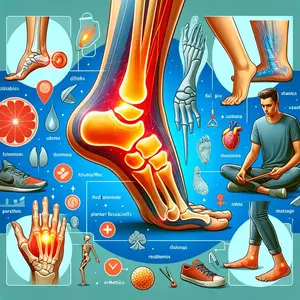Plantar Fasciitis and Flat Feet – Everything You Should Know
In this article, I will explain the connection between plantar fasciitis and flat feet.
You’ll learn how flat feet influence foot health and plantar fascia function.
Let’s start.
Plantar Fascia and Flat Feet
Plantar Fasciitis is a condition that involves the inflammation of the plantar fascia, a thick band of tissue running along the bottom of the foot, connecting the heel bone to the toes.
Flat Feet, also known as fallen arches or flatfoot, occur when the arches on the inside of the feet flatten, allowing the entire sole to touch the floor when standing.
The Influence of Flat Feet on Plantar Fascia
Plantar fascia runs along the bottom of the foot and is responsible for supporting the medial longitudinal foot arch and weight distribution during walking or standing.
With flat feet (pes planus), the medial longitudinal arch of the foot is fallen. That can lead to changes in the function of the plantar fascia.
Instead of supporting the arch of the foot, plantar fascia shifts its primary role to shock absorption when walking, running or jumping.
In that scenario, the plantar fascia becomes vulnerable to overuse injuries and inflammation, which means the chances of plantar fasciitis increase.
Foot Overpronation and Plantar Fasciitis
Foot overpronation – inward rolling of the foot more than 15 degrees when walking or standing.
Overpronation goes along with flat feet. If a person has a flat foot, usually the foot overpronation is present as well.
Overpronation leads to increased load and stress on the plantar fascia, especially if your ankle flexibility is limited. (dorsiflexion).
Dealing With Plantar Fasciitis
Stretching the Plantar Fascia
One of the most effective ways to alleviate the discomfort of plantar fasciitis is through targeted stretching.
Gentle stretches can help loosen the plantar fascia, reducing pain and improving foot function.
For detailed guidance on plantar fascia stretches, visit Plantar Fascia Stretch and Plantar Fasciitis Stretches, which offer step-by-step instructions and tips for effective stretching routines.
Differentiating from Heel Spurs
It’s essential to distinguish plantar fasciitis from similar conditions, such as heel spurs, to ensure appropriate treatment.
Heel spurs and plantar fasciitis have distinct causes and may require different management strategies.
Understanding these differences can be crucial for effective treatment, as discussed in detail at Difference Between Plantar Fasciitis and Heel Spurs.
Comprehensive Information on Plantar Fasciitis
For a more in-depth understanding of plantar fasciitis, including its causes, symptoms, and a range of treatment options, the article Plantar Fasciitis provides comprehensive information.
This resource is invaluable for anyone looking to gain a holistic view of the condition.
Plantar Fasciitis and Related Pain
Plantar fasciitis can sometimes lead to or be associated with pain in other parts of the body, such as the knees.
The article Can Plantar Fasciitis Cause Knee Pain? explores the potential connections between plantar fasciitis and knee pain, offering insights into how these conditions may be interrelated.
Massage Therapy for Plantar Fasciitis
Massage therapy is another effective tool in managing plantar fasciitis. It can help relieve pain, reduce inflammation, and improve circulation in the affected area.
For techniques and benefits of massage for plantar fasciitis, visit Plantar Fasciitis Massage.
Tools for Managing Plantar Fasciitis
Various tools can aid in the treatment and management of plantar fasciitis.
These tools are designed to provide relief, support healing, and prevent future occurrences.
For a guide on the best tools for dealing with plantar fasciitis, check out Best Tools for Plantar Fasciitis.
Conclusion
Dealing with plantar fasciitis effectively requires a multifaceted approach, incorporating stretches, understanding the condition, massage therapy, and the use of specialized tools.
Utilizing these resources and techniques can significantly aid in the management and alleviation of plantar fasciitis symptoms.
Summary
| Aspect | Effect on Plantar Fascia | Risk of Plantar Fasciitis |
|---|---|---|
| Flat Feet | Flat feet can lead to increased strain on the plantar fascia due to lack of proper arch support. | Individuals with flat feet have a higher incidence of plantar fasciitis due to altered pressure distribution across the foot. |
| Overpronation | Overpronation causes excessive inward rolling of the foot, putting additional stress on the plantar fascia. | Excessive pronation is a significant risk factor for developing plantar fasciitis, especially in non-athletes with limited ankle dorsiflexion. |
| Combined Impact | Both flat feet and overpronation can result in altered foot mechanics, increasing the risk of plantar fasciitis. | The combination of flat feet and overpronation increases susceptibility to injuries, microtears, and inflammation in the plantar fascia. |






